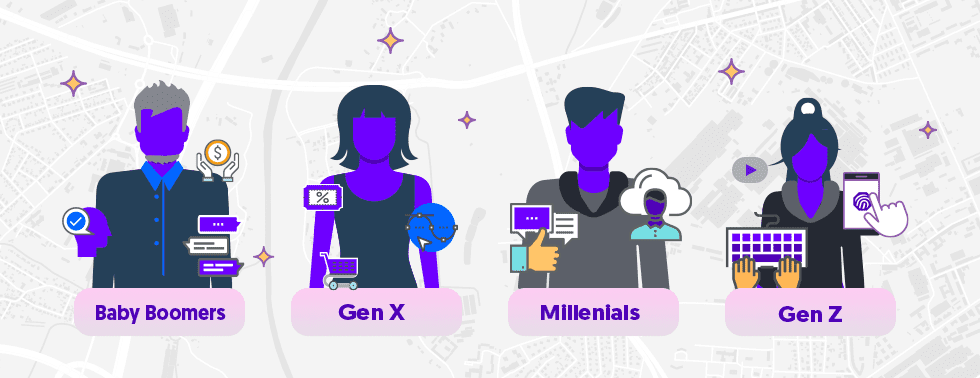Messaging in marketing campaigns is highly dependent on the target demographic. Age range and generation are sometimes used interchangeably but segmentation by age does not address the complexities of generations. Generational marketing is exactly what it sounds like: identifying and marketing to the specific values that resonate with each generation. Defining generational boundaries is usually determined by the available technologies or major political events that change the trajectory of that age group’s collective attitudes.
It’s often quite intuitive. We would never expect Baby Boomers and Gen Z to be receptive to the exact same messaging. At different stages in life and accustomed to different technologies, they don’t have a lot in common. But generations that border each other and have shared experiences have more complex relationships. These blurred boundaries can tell us more about the larger trends that underlie effective generational marketing.
Social media, while used by Baby Boomers, is undoubtedly the hallmark of Millenials and Gen Z. As native users their embrace of social media presents unique opportunities for brands engaging in social media marketing. By identifying how to effectively market to each generation on social media, brands can syndicate targeted content to retailers on the correct platforms to reach the right audience with a message that resonates.
Stage of Life and Generational Values
Millennials have been in the media spotlight for years, whether it’s their infamously rocky entry into the workforce amid the Great Recession or their hyperbolic love of avocado toast. Their purchasing habits have been scrutinized endlessly – they’ve “killed” many industries that they couldn’t afford to participate in. With the oldest Millenials now in their 40’s, most of the generation is facing (or approaching) major life changes: management roles at work, marriage, children, etc.
Now Gen Z is entering the workforce with the cohort’s oldest members between the ages of 23-26, depending on how you define the generation’s boundaries. Their shopping habits have been largely shaped by the emerging technologies of their adolescence, just as every generation before them. It’s true that Gen Z grew up utilizing the unprecedented technology of the internet. But it’s more accurate to say they grew up on the internet, using digital platforms as a primary method for everything from socializing to e-sports.
Millennials are aging out of the traditional analysis of young adults. Popular evaluation of these two generations lumps them together due to the common experience of being internet natives. But there’s a growing focus on how Millennials now make up the largest segment of the workforce. It shifts marketers’ attention to how stages of life, such as the average age that people buy homes and have children, inform us which products appeal to that age range. But generational values run deeper and help us understand what about a specific product or brand converts a potential customer.

The shoe company Toms, for example, was favored by Millennials when they were young adults. Toms didn’t invent the buy-one give-one to a person in need model but their successful targeted marketing did popularize it. It appealed to Millennials’ sense of justice; they respond well to brands that support social and environmental causes. The initiative exposed logistical issues though, so Toms’ shift to investing ⅓ of profits for grassroots good is a practical response that fulfills their promise to consumers.
The novelty of this strategy has worn off simply because of the generational shift. Gen Z is not impressed by a robust corporate social responsibility program; they’ve come to expect it as standard. Throughlines like this, combined with data about social media usage by generation, provide insight into effective social media marketing that generates brand loyalty.
Trends
We’ll focus on generations that are responsive to digital advertising and active on social media.
Baby Boomers use social media as an entry point to brand and product research. They respond to straightforward content and good customer service.
Gen X responds to incentives. Loyalty programs, discount offers through social media, and clear purchase paths will hold their attention.
Millennials enjoy user-generated content and interacting with influencers. Honest product reviews, good deals, and brands that support causes can gain their loyalty.
Gen Z is the most active on social media and relies on it the most for product and brand information. They are most easily engaged in social and economic causes, mobile interactions, and video content.

Maximize Impact
Effective generational marketing requires carefully selecting social media platforms as primary advertising destinations. Once you’ve determined a primary social media platform, content can be optimized to appeal to your target generation’s values. The majority of Instagram’s user base is users under 34. That’s some Millennials and most of Gen Z. Keeping in mind their values and preferred platforms, Instagram is an ideal platform for brands to utilize rich visual media and demonstrate the success of their corporate social responsibility programs. Identifying these patterns has a huge impact on your social media marketing strategy. It provides a guideline for more effective content. If your brand is looking for a new way to collaborate with retailers, adapting your strategy in this way creates an opportunity to syndicate compelling content to retailers.

Syndicate Content
Distributing social content to retailers enables brands to tap into hyper-local audiences. Activating hundreds of retailers in your brand’s social network increases reach across the board. The incremental change adds up to a meaningful improvement in impressions per post.
ThumbStopper connects brands’ high-quality content to their retailers’ social media and search engine destinations. And with new and improved generationally targeted content, your brand can enhance both brand and retailer social presence.
Book a demo to learn more about ThumbStopper.





